Perfect Vanilla Butter Cake
This is the only Vanilla Butter Cake recipe you’ll ever want or need. Mixing technique can make a big difference when making cake batter. Find out the best way to get a light and tender cake.
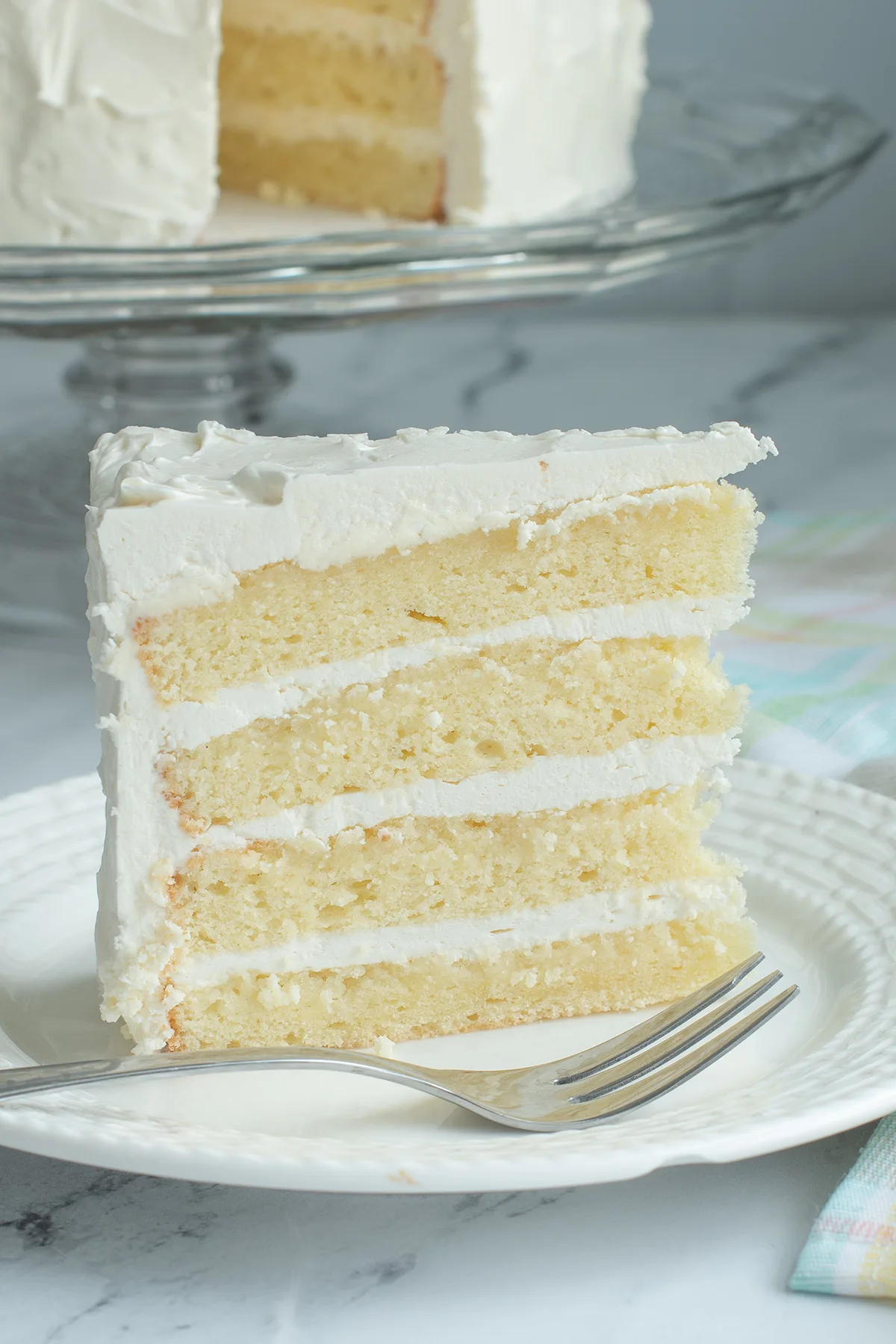
Table of contents
Why this is the best Vanilla Butter Cake Recipe
First of all this is a great recipe because it is a balanced recipe.
Professional bakers use the “Baker’s Percentage” to balance the ingredients in a recipe. With this knowledge I worked for months developing the best vanilla cake.
In fact, this exact recipe was the base for hundreds and hundreds of wedding cakes I sold when I had my wedding cake business.
You can find the percentages for this Vanilla Butter Cake recipe in this all-encompassing post describing how to create the best cake recipes.
Once you have a balanced recipe you need to think about mixing technique.
I make my butter cakes using the “reverse creaming” method of mixing. Reverse creaming makes a cake with a soft and tender crumb. You can see side by side comparisons of reverse and traditional creaming below.
Recipe Ingredients
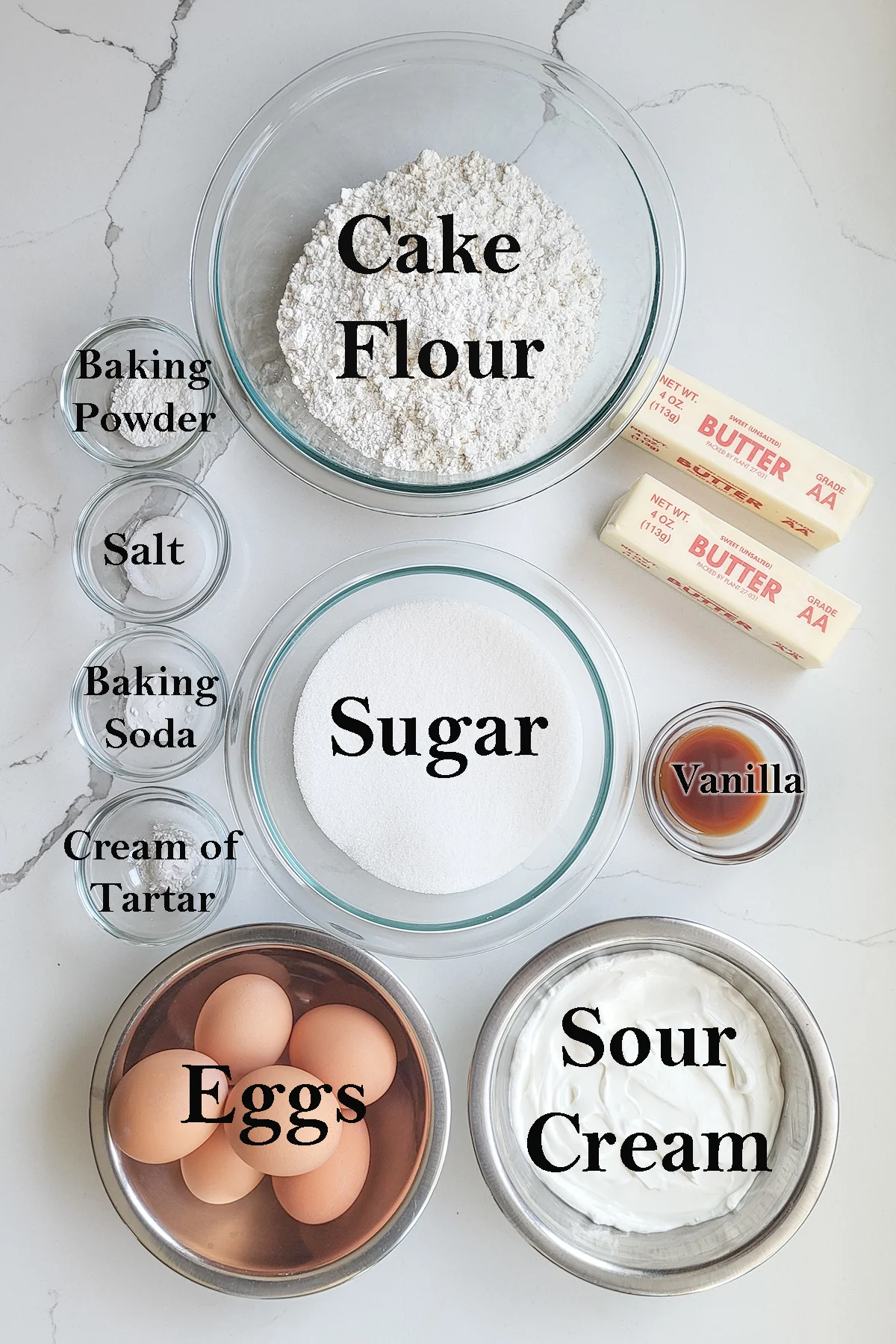
Ingredient Notes
- Cake Flour – Has a lower protein content than all purpose flour so it makes a softer cake. I prefer bleached cake flour. Bleached cake flour is acidic which tenderizes the cake and allows the batter to absorb more liquid for a moister cake.
- Sour Cream – Is used instead of milk as the “liquid” in this batter. Because sour cream is acidic it tenderizes the crumb of the cake and the added fat enriches the batter.
- Eggs – Extra egg yolks in the batter enriches the cake and emulsifies the batter for an even and soft crumb. The whites are whipped and folded into the batter for an extra light and soft cake crumb.
- Cream of Tatar – This acidic ingredient stabilizes the whipped egg whites and acidifies the batter for a softer crumb.
Process Photos
See the recipe card for detailed instructions and measurements.
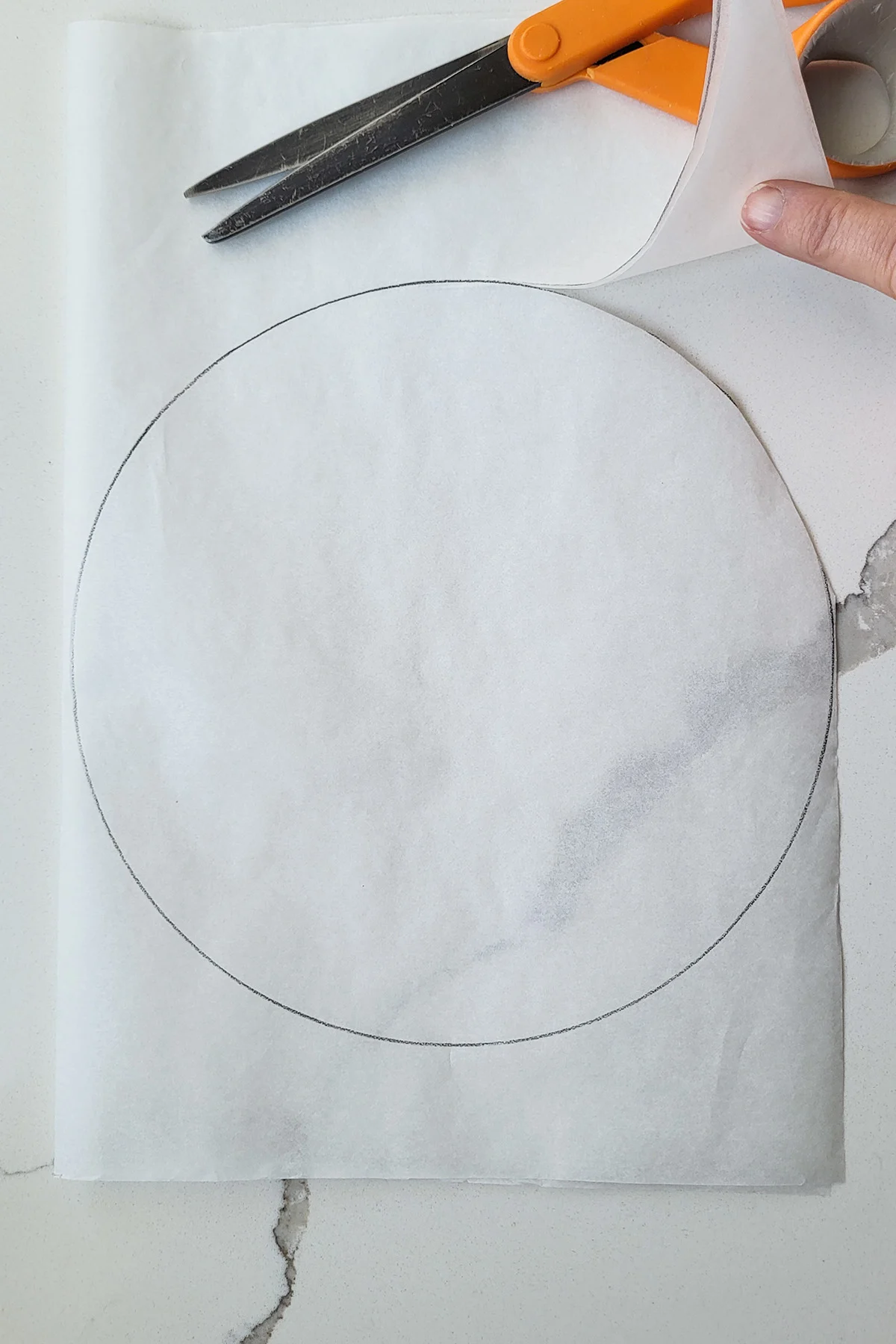
- Draw an 8″ circle on parchment paper using your cake pan as a guide. Cut out two circles and use them to line your cake pans.
- If you don’t have parchment paper butter and flour the bottom of the cake pan only, not the sides.
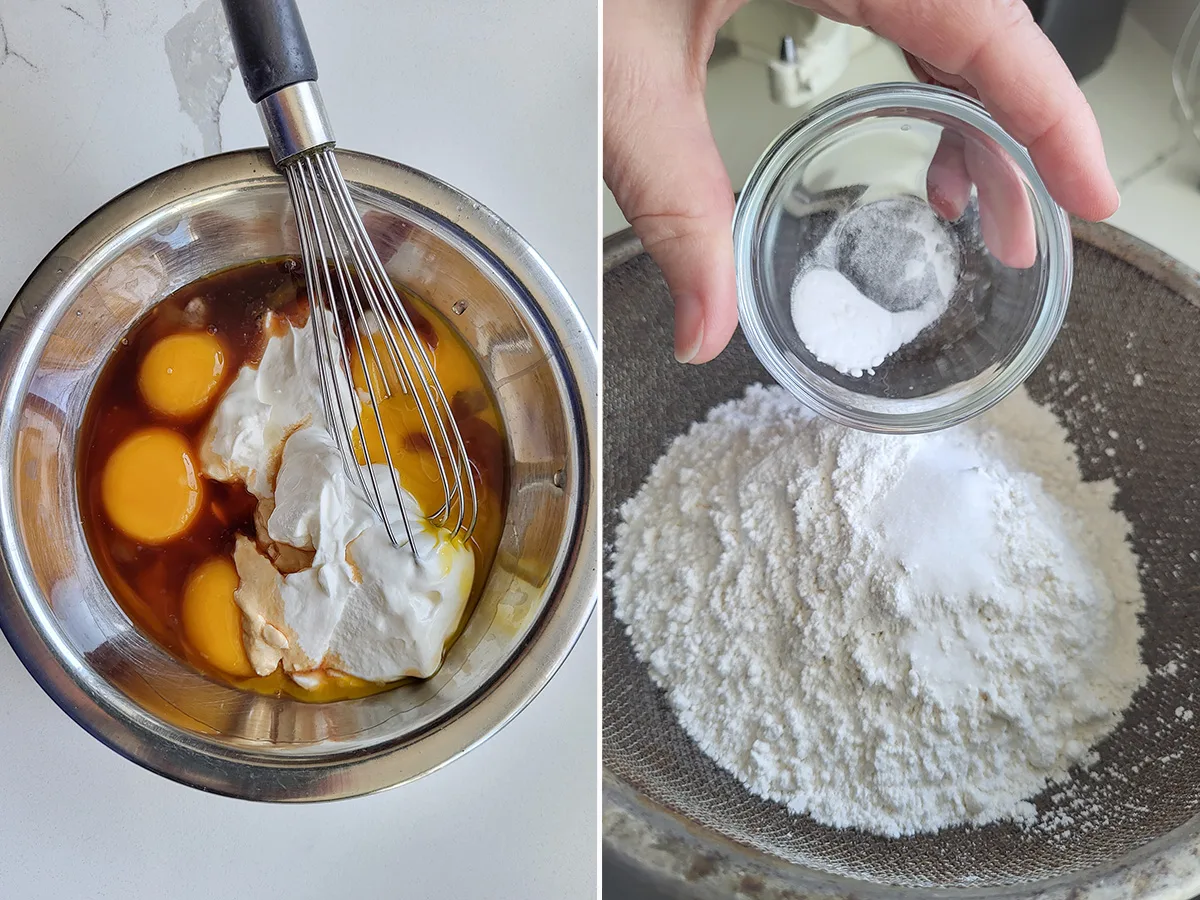
- In a small bowl whisk together the yolks, sour cream and vanilla.
- Sift the dry ingredients into a mixing bowl.
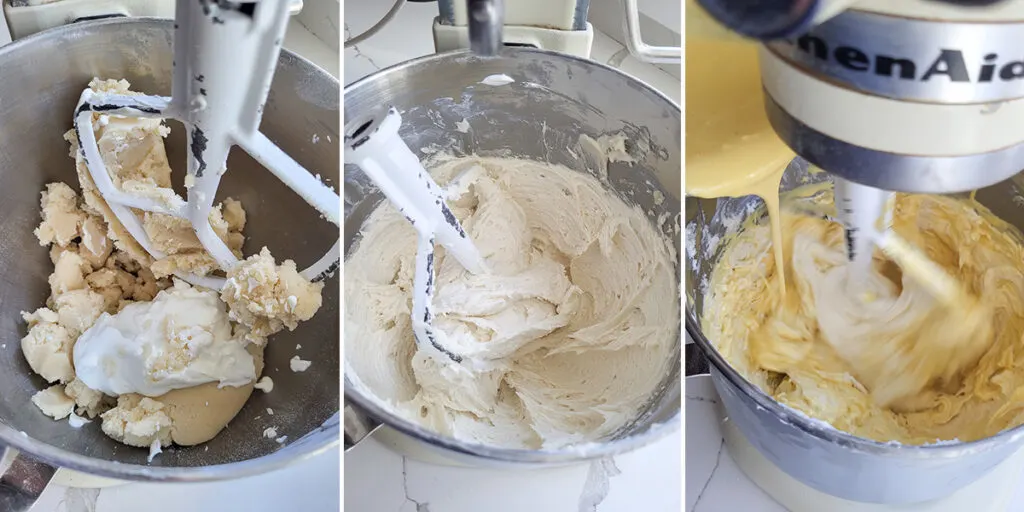
- Mix the dry ingredients on low speed and add the butter. Mix until it forms a thick paste. Add the reserved sour cream.
- Mix the batter on high speed until it is light and aerated. Scrape the bowl and beater.
- With the mixer running on low, add the yolk mixture. Mix until combined.
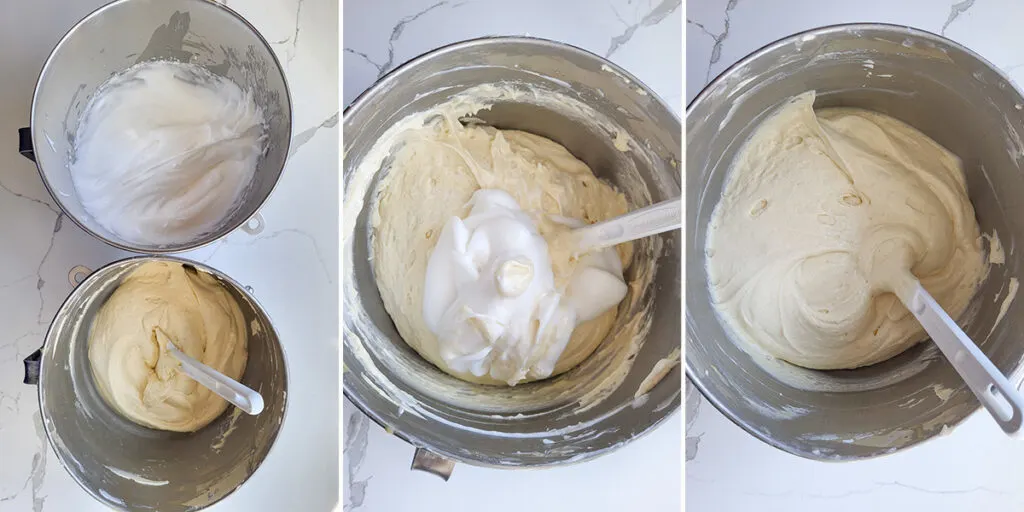
- Whip the whites with the cream of tarter and the remaining sugar. Do no overwhip the whites.
- Fold the whites into the batter in two batches.
- Fold just until there are no streaks of whites.
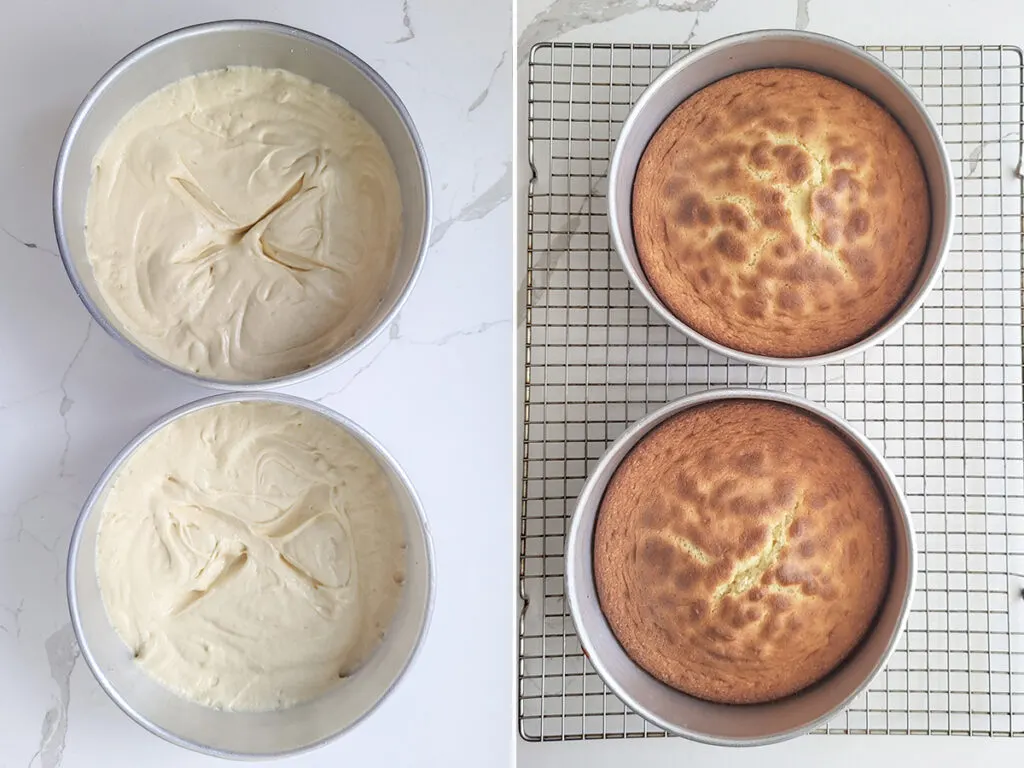
- Evenly divide the batter between the two pans. Smooth to even level then use the tip of your spatula to make an “X” in the center of each cake. This will help the cake rise more evenly in the oven.
- Bake until the center of the cake springs back when lightly pressed. Cool in the pan for 20 minutes then cool completely before icing.
What’s the difference between vanilla cake and yellow cake?
Most people use the terms “vanilla cake” and “yellow cake” interchangeably. Vanilla is the flavoring in the cake. The cake is yellow because of the eggs in the cake.
That being said, not all vanilla cakes are yellow cakes. If you eliminate the egg yolks in the cake and make white cake flavored with vanilla, it too is a vanilla cake.
Reverse Creaming vs. Traditional Creaming
Before posting this recipe I decided to do a quick kitchen experiment to back up my claims that reverse creaming is the way to go for this cake.
I used the same ingredients and mixed them with traditional creaming, reverse creaming and reverse creaming with the eggs separated and the whites whipped and folded in.
There were distinct differences between the three cakes.
- Cake 1 (traditional creaming method) had an open and regular crumb, but was not as tender as I would like and it had a slightly oily mouth-feel.
- Cake 2 (reverse creaming) was very tender, velvety and soft.
- Cake 3 (reverse method with whipped whites) had a slightly irregular but very tender crumb. It was not quite as velvety as cake 2, but it was lighter and quite tender. This was my favorite cake!

Three cakes with the exact same ingredients, but different mixing methods. Left=Traditional Method, Middle=Reverse Creaming, Right=Reverse with Whipped Whites
This is a really great all purpose yellow cake that is tender yet strong enough for stacking or carving. For more information about cake batter, visit the Baking School page.
Frosting your Cake
I like this recipe filled and iced with Italian Meringue Buttercream or Swiss Meringue Buttercream.
American Buttercream is slightly sweeter than meringue buttercream and is also nice with this cake.
Storage
The uniced cake can be stored for 2-3 days at room temperature for up to 2 months in the freezer. Do not refrigerate the cake unless it is filled or iced with a perishable frosting.
More Cake Recipes
Now that you’ve made this recipe what should you do with all the extra egg whites? Check out this collection of recipes that use extra whites for some great ideas.
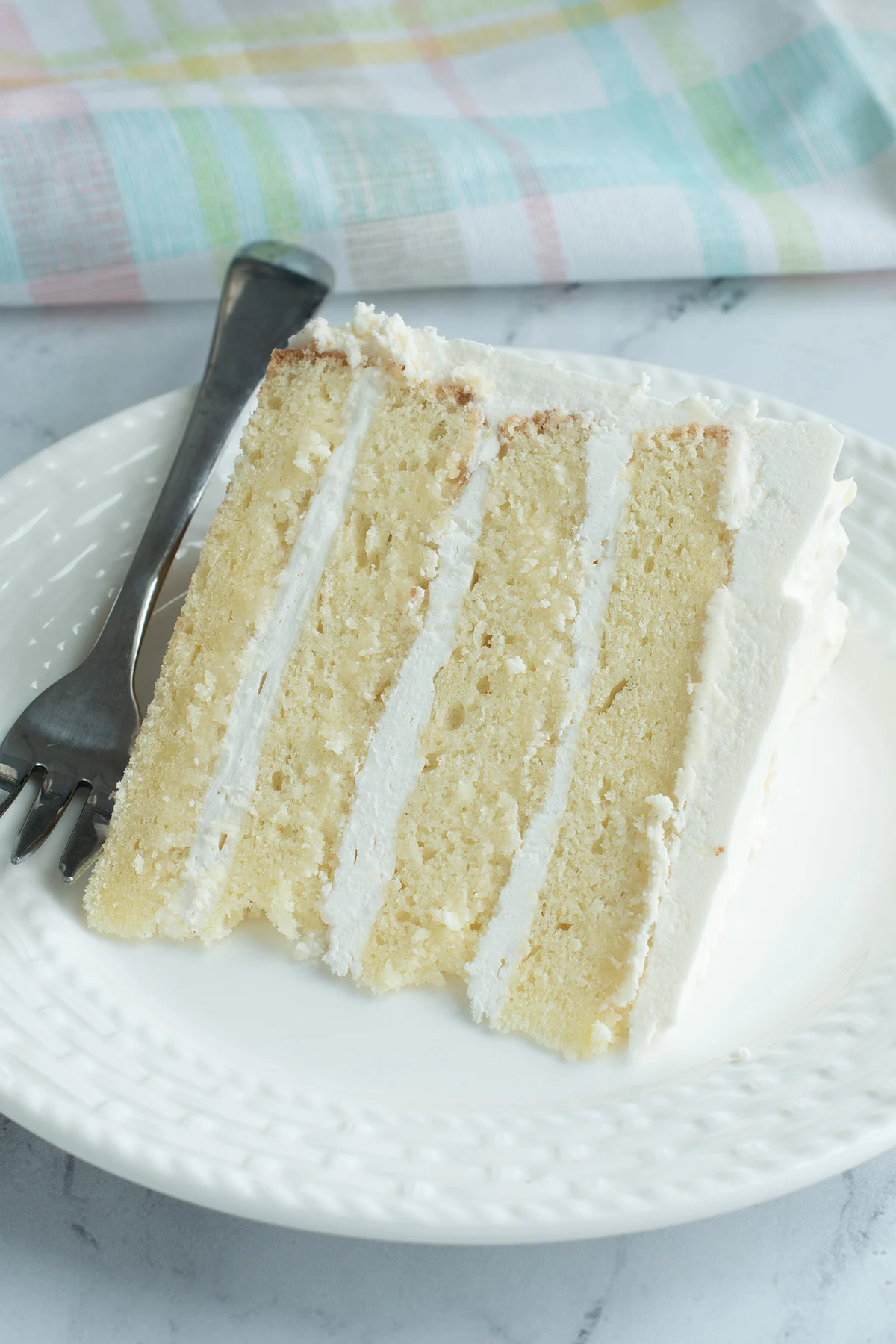
If you love this recipe as much as I do, please consider leaving a 5-star review.
Vanilla Butter Cake Recipe
Ingredients
- 6 large egg yolks (room temperature)
- 8 ounces sour cream (1 cup, room temperature, divided)
- 1 tablespoon vanilla extract
- 12 ounces granulated sugar (1 ½ cups, divided)
- 9 ounces cake flour (2 cups, see note)
- ¾ teaspoon baking powder
- ¾ teaspoon salt
- ¼ teaspoon baking soda
- 8 ounces unsalted butter (room temperature)
- 3 large egg whites (room temperature)
- ¼ teaspoon cream of tarter
Instructions
- Preheat the oven to 350 °F. Line two 8"x3" round cake pans with a circle of parchment paper or butter and flour the bottom of the pans only, not the sides.
- Combine 6 large egg yolks, 1/2 the sour cream and 1 tablespoon vanilla extract in a small bowl, whisk to combine, set aside.
- Into a mixer bowl put 1 ¼ cups of the sugar, sift in 9 ounces cake flour, ¾ teaspoon baking powder, ¼ teaspoon baking soda and ¾ teaspoon salt. Mix on low speed for 10 seconds to distribute the leavening. Add 8 ounces unsalted butter to the flour mixture. Mix on low until the butter is incorporated and the batter looks like a paste. Add the other ½ of the sour cream to the flour and butter mixture. Increase the speed to medium and mix about 3 minutes until the batter lightens in texture. If you're using a hand mixer add another minute or two to the total time.
- Scrape the sides and bottom of the bowl. With the mixer on low, add ½ the egg yolk mixture. Mix until mostly incorporated. Scrape the sides and bottom of the bowl. Add the rest of the egg yolk mixture. Scrape the bowl and mix until incorporated.
- In another bowl, whip 3 large egg whites with ¼ teaspoon cream of tarter on medium high until they form soft peaks. Turn the mixer to medium low and slowly add the remaining ¼ cup of sugar. Turn the mixer to medium high and whip the whites to full peak. Fold the whites into the base in 2 parts, folding just until there are no streaks of egg whites.
- Divide the batter between the 2 pans and spread so it’s level.
- Bake until the center of the cake springs back when lightly pressed or a toothpick inserted into the middle of the cake comes out clean, about 25-30 minutes.
- Cool 10 minutes in the pan and then turn out onto a cooling rack. When fully cooled, wrap in plastic and refrigerate at least 3 hours or overnight before filling and assembling the cake with your favorite frosting.
Would you like to save this recipe?
As an Amazon Associate and member of other affiliate programs, I earn from qualifying purchases.

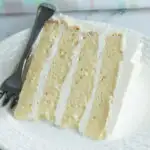
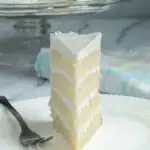
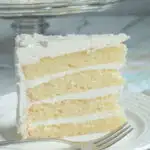
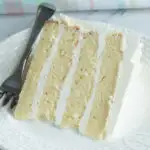





It’s me again Eileen, please do you have a recipe for an excellent Red Velvet cake. Thing is, I don’t even know if the perfect Red Velvet cake should be more moist than fluffy or vice-versa.
Thoughts on my dilemma?
Thanks so much.
I have a Red Velvet Cake recipe I’ve been working on but isn’t published yet. It will be in the future. As far as moist vs. fluffy, that will always be a matter of taste. I prefer moist, but not gummy and wet.
Hahahahaha, now it’s hard to get that balance really… I can’t wait to see what you come up with Eileen. Thanks so much again.
PS: I prefer moist as well
Hi Eileen, I really appreciate the painstaking time and effort you put into getting at perfection.
In this recipe there’s no mention of milk or buttermilk, can I ask why? Cos I’ve seen either (especially the latter) used in recipes for this same cake by others.
A detailed explanation would be really awesome.
Thanks.
Hi Tobi, the sour cream takes the place of milk or buttermilk. I like it because it adds fat and the acidity tenderizes the cake crumb.
Oh really?
Thanks… I can’t get sourcream here, can I use normal yoghurt instead (no Greek either)?
Yes, you can use regular yogurt instead of the sour cream.
Hi Eileen, I have the same problem as Tobi, I would love to do this cake but in my country (Argentina) we don’t have sour cream. So, can I replace it with the same amount of plain yogurt? Is there another option to replace the sour cream? Thanks!
Hi Marina, Yes, you can use plain yogurt to replace sour cream. I don’t know what yogurt is like in Argentina since the texture can vary. Here, regular yogurt is a little thinner than sour cream. Greek yogurt is very rich and thick, more like sour cream. I would suggest using a full fat yogurt to get as close to sour cream as possible.
Hi Eileen,
I have the same problem as Tobi because where I live (Argentina) we don’t have sour cream. So, can I replace it with the same amount of plain yogurt? Can I replace it with something else? Thanks!
Sorry for posting twice! I thought I could not send the first post!
Good Morning! I was so excited to find your post. My granddaughters, 8 & 9 this year, always request I make their cakes, and I decided it time to make a good homemade cake instead of a box cake for them. This year my challenge is a unicorn and mermaid cake, so I need a cake that will make and hold up to layers (6″ cake).
I have tried both the vanilla and chocolate butter cakes. I had trouble with both cakes, but especially the chocolate cake falling after taking it out of the oven. It has the consistency of a brownie instead of a cake. The vanilla did the same thing but not to the same extent. I personally prefer the vanilla, it was delicious! I have also tried the Italian Buttercream Icing. LOVE it! I must admit the first batch I made with the vanilla cake, I used salted butter by mistake and I could taste the salt. Some people liked it, and it was good, but I could taste the salt. So this time with the chocolate cake trial run I made sure to use the unsalted butter, much better (for my taste) Interesting lesson to learn.
Can you give me any insight as to why the cakes fell or compressed? I did use the reverse creaming method and folded in the egg whites.
I appreciate your time and look forward to your reply.
Hi Tina. I’ve been making the vanilla and chocolate version of this cake for more than 10 years and have never had a “brownie” type of texture for the cake. The cake will “settle” once it comes out of the oven. It may bake up with a hump in the middle that will settle down as it cools. But it should still be the texture of a cake, not a brownie. Did you butter the sides of the pan? I’ve found the cake bakes better if the sides of the pan are not buttered at all.
Thanks Eileen, I did butter the bottom of the pans, but not the sides. I read more this morning and I am going to try just the parchment paper, no butter on my next try as you suggested. I don’t think that brownie is the best description, but the chocolate was not as light as the vanilla, but still very tender and moist. I can ‘t wait to try it again! My co-workers don’t seem to mind!!!
Hi Tina. If you’re used to baking from a cake mix, this cake does have a different texture than a box cake. It’s not as light as a cake mix because it’s more buttery. My Old Fashioned Chocolate Cake has that lighter texture if you want to try that recipe. The cake also should be eaten at room temperature, not cold. Let me know if I can answer any other questions.
Hi Eileen! Thank you for such a wonderful website. This recipe says “Turn the mixer to medium low and slowly add the remaining 1/4 cup of sugar.” Do I add the 1/4 sugar to the batter or to the whipped egg whites? I added it to the whipped egg whites but was not quite sure. The cake turned out incredibly delicious although I inadvertently left out the 1/4 baking soda. Hence, the cake fell a little when I removed it from the oven, but still incredibly moist and yummy.
Hi Kay. You did it exactly right, the last 1/4 cup of sugar goes in with the egg whites. This type of cake always “settles” when it comes out of the oven. If you read the update at the end of my White Cake post it explains why.
Hi Eileen!
I just found the Baking Sense site because I will be making my brother-in-law’s wedding cake this fall. Your site is so informative and easy to understand! Would you recommend this cake for a semi-naked style presentation? I know that the edges have to caramelize a bit so you can see the color of the cake but you also don’t want to drag a lot of crumb during the smoothing process so it has to be somewhat dense (and probably chilled during the frosting process I would think). Additionally, are there any frosting recipes you would suggest for the semi-naked style cake? Thank you so much for your help!
Hi Brittany. I’ve used this recipe for semi-naked cakes. Personally, I prefer to lightly trim the edges so the sides are less brown when they show through. You can see a video in this post that shows photos of how I trim the sides of the cake. Yes, it is easier to trim and stack the cakes when they’re chilled. I’ve done the semi-naked cakes with both whipped cream and Italian Meringue Buttercream filling/frosting.